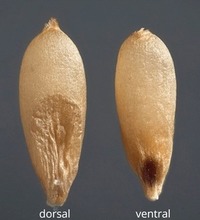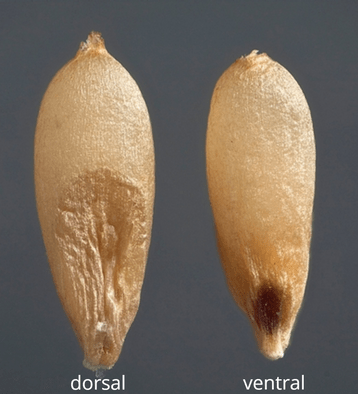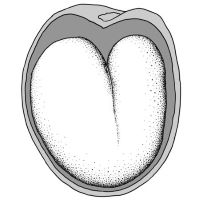Content is from Kirkbride et al. 2006Kirkbride et al. 2006:
Kirkbride JH, Jr, Gunn CR, and Dallwitz MJ. 2006. Family guide for fruits and seeds, vers. 1.0. Accessed September 2020-January 2022. URL: https://nt.ars-grin.gov/seedsfruits/keys/frsdfam/index.cfm ., without modification.
Updates are forthcoming.
Fruits: Pistil(s) compound; 1; 1-pistillate; with carpels united. Fruit pericarpium; schizocarpschizocarp:
usually dry fruit splitting between two or more locules to form distinct, indehiscent, usually one seeded segments; fruit derived from a single, superior or inferior, compound ovary; compare to mericarp , or simple; acheneachene:
, or simple; acheneachene:
a dry, indehiscent, one-seeded fruit, with seed attached to pericarp at a single point, derived from a single, superior, simple or compound, one-loculed ovary (Cypselocarpus of author, not Spjut); camarium; with persistent central column, or without persistent central column; valves not diverging at top of central column; not within accessory organ(s); 1-seeded to many-seeded; 1-seeded (-many); less than 1 cm long to from 1–5 cm long; 0.2–1.2 cm long; with Cypselocarpus 1-carpellate (-many); with carpels united; with carpels remaining united at maturity; without sterilesterile:
(Cypselocarpus of author, not Spjut); camarium; with persistent central column, or without persistent central column; valves not diverging at top of central column; not within accessory organ(s); 1-seeded to many-seeded; 1-seeded (-many); less than 1 cm long to from 1–5 cm long; 0.2–1.2 cm long; with Cypselocarpus 1-carpellate (-many); with carpels united; with carpels remaining united at maturity; without sterilesterile:
lacking male and/or female reproductive parts; also, not producing fruit or seed
 carpels; not sulcatesulcate:
carpels; not sulcatesulcate:
surface relief—having one or more elongate, relatively narrow and shallow depressions or grooves ; in transection tereteterete:
; in transection tereteterete:
approximately circular in cross section; width and thickness approximately equal
 ; apexapex:
; apexapex:
the point farthest from the point of attachment, or the "tip" of an organ not beaked; indehiscentindehiscent:
not beaked; indehiscentindehiscent:
not opening on its own, as in a fruit
 (Cypselocarpus & Tersonia but eventually falling apart), or dehiscentdehiscent:
(Cypselocarpus & Tersonia but eventually falling apart), or dehiscentdehiscent:
(v. dehisce) splitting open at maturity to release contents (of a fruit) . Dehiscentdehiscent:
. Dehiscentdehiscent:
(v. dehisce) splitting open at maturity to release contents (of a fruit) unit seed(s). Dehiscentdehiscent:
unit seed(s). Dehiscentdehiscent:
(v. dehisce) splitting open at maturity to release contents (of a fruit) passively; linearly; by dorsaldorsal:
passively; linearly; by dorsaldorsal:
abaxial; the back of an organ; the side away from the axis (compare ventral)
 sutures, or ventralventral:
sutures, or ventralventral:
adaxial; of the side of an organ facing the axis (compare dorsal)
 sutures; and shedding seeds; without replumreplum:
sutures; and shedding seeds; without replumreplum:
the rim, formed by the persistent placentas, and connected by a false septum in Brassicaceae fruits. The fruit valves are attached to this rim and separate from it in dehiscent fruits.
. Epicarpepicarp:
outer layer of fruit wall or pericarp, if divided into layers; note here used synonymously with exocarp durable; glabrousglabrous:
durable; glabrousglabrous:
without hairs
; without armature; without wing(s); without apicalapical:
at or pertaining to the end of the seed or fruit distal from its point of attachment (i.e., base)
respiratory hole. Mesocarpmesocarp:
the middle layer of the pericarp, if divided into layers absent. Endocarpendocarp:
absent. Endocarpendocarp:
the inner layer of the pericarp, if divided into layers present; not separating from exocarpexocarp:
present; not separating from exocarpexocarp:
outer layer of fruit wall or pericarp, if divided into layers; note here used synonymously with epicarp ; thin; not splitting into 1-seeded pyrenes; smooth; without wing; without operculumoperculum:
; thin; not splitting into 1-seeded pyrenes; smooth; without wing; without operculumoperculum:
a dehiscent cap (or lid) of a seed or fruit that opens during germination or dehiscence ; without secretory cavities; without mechanism for seedling escape; without grooves; without longitudinallongitudinal:
; without secretory cavities; without mechanism for seedling escape; without grooves; without longitudinallongitudinal:
of or relating to length or the lengthwise dimension
ridges. Funiculusfuniculus:
(alt. funicle) stalk connecting the ovule (later seed) to the ovary (later fruit) placenta short; short without seed bearing hookswith hooks:
short; short without seed bearing hookswith hooks:
bristles or spines with curved or backwards pointing tips, or with secondary bristles along their length (retinacula); not persisting in fruit after seed shed.
(retinacula); not persisting in fruit after seed shed.
Seeds: Arilaril:
(broad sense) appendicular structure that wholly or partly envelops a seed and is produced from or a modification of the funicle, raphe, or outer integument; usually fleshy or pulpy, sometimes spongy or tufted-capillate, often brightly colored present; a true arilaril:
present; a true arilaril:
(broad sense) appendicular structure that wholly or partly envelops a seed and is produced from or a modification of the funicle, raphe, or outer integument; usually fleshy or pulpy, sometimes spongy or tufted-capillate, often brightly colored ; cream and white (or pale & tranlucent); well developed (large to small); adnate to hilumhilum:
; cream and white (or pale & tranlucent); well developed (large to small); adnate to hilumhilum:
on seeds, the scar indicating where the funiculus was attached; on grass caryopses, the scar visible on the outer fruit surface revealing where the seed is attached on the inner fruit wall surface; or in Asteraceae cypselae, the scar visible on the outer fruit wall revealing where the fruit was attached to the receptacle ; fleshy; of funicularfuniculus:
; fleshy; of funicularfuniculus:
(alt. funicle) stalk connecting the ovule (later seed) to the ovary (later fruit) placenta origin; encompassing, or marginalmarginal:
origin; encompassing, or marginalmarginal:
at, on, or close to the margin or border
, or basalbasal:
at or pertaining to the point of attachment; (of embryo) embryo occupies one end of the seed
; does not aid in seed explusion from fruit; fleshy. Seed minute to larger than minute; less than 1 mm long to 1 to less than 5 mm long; 1–4 mm long; C-shapedC-shaped:
2D-shape—semiannulate, curved into the shape of the letter 'C'
, or circularcircular:
(of embryo) linear embryo is curved into an "O" shape , or hippocrepiformhippocrepiform:
, or hippocrepiformhippocrepiform:
3D shape—horseshoe-shaped
, or obovoidobovoid:
3D shape—obovate
, or triangulartriangular:
2D shape—three relatively straight sides with distinct corners; more angular than teardrop-shaped ; in transection compressedcompressed:
; in transection compressedcompressed:
flattened; in grasses, used to denote compression (not necessarily flattened) either laterally or dorsiventrally
; not bowl shaped; not nutlike; without winglike beakbeak:
a usually firm, terminal appendage, sometimes tapered ; without caudatecaudate:
; without caudatecaudate:
tapering to a long, tail-like appendage appendage(s); at maturity with food reserves; with endosperm (Goldberg questioned, but did not answer, whether endosperm or persisperm. Based on literature perispermperisperm:
appendage(s); at maturity with food reserves; with endosperm (Goldberg questioned, but did not answer, whether endosperm or persisperm. Based on literature perispermperisperm:
seed nutritive tissue comparable to the endosperm, but derived from the nucellus (maternal tissue)
not scored); without canavanine. Sarcotestasarcotesta:
pulpy or fleshy outer layer of the seed coat, simulates aril absent. Testatesta:
absent. Testatesta:
seed coat
 present; without fleshy or leatheryleathery:
present; without fleshy or leatheryleathery:
texture—moderately thick, tough, and very pliable
layer over hard layer; tight; surface unsmooth, or smooth; surface with merged raised features, or discreet raised features; surface papillatepapillate:
surface relief—bearing minute, distinct, broad-based projections, tapering to a rounded apex ; surface ridgedridged:
; surface ridgedridged:
surface relief—raised, thick ridges, sharp edged or rounded, usually in a series that may cover the entire surface , or rugoserugose:
, or rugoserugose:
wrinkled , or reticulatereticulate:
, or reticulatereticulate:
surface relief—netted, raised walls or concave grooves forming a net-like surface pattern with flat, concave, or convex interspaces ; with crease or line separating cotyledons from hypocotyl-radicle; with notch along margin where cotyledons from hypocotyl-radicle tip approaching each other; without glands; without bristles; pubescentpubescent:
; with crease or line separating cotyledons from hypocotyl-radicle; with notch along margin where cotyledons from hypocotyl-radicle tip approaching each other; without glands; without bristles; pubescentpubescent:
surface relief—bearing hairs
; without glandularglandular:
surface relief—covered with small, raised secretory glands, regular or irregularly shaped, translucent or opaque, and maybe distinctly colored pubescence; without wings; without collar; without operculumoperculum:
pubescence; without wings; without collar; without operculumoperculum:
a dehiscent cap (or lid) of a seed or fruit that opens during germination or dehiscence ; colored; monochrome; reddish- or orangish- brown (all shades); not becoming mucilaginousmucilaginous:
; colored; monochrome; reddish- or orangish- brown (all shades); not becoming mucilaginousmucilaginous:
resembling mucilage; moist and sticky
when wetted; surrounding embryo. Endosperm copious, or scant; fleshy; smooth; with oils; without fatty acid containing cyclopropene; without apicalapical:
at or pertaining to the end of the seed or fruit distal from its point of attachment (i.e., base)
lobes; without chlorophyll; without isodiametric faceted surface; without odor. Embryo differentiated from food reserve; well developed; 1 per seed; partially filling testatesta:
seed coat
 (with food reserve); longer; at one end of seed not extending into a depression or cup; peripheralperipheral:
(with food reserve); longer; at one end of seed not extending into a depression or cup; peripheralperipheral:
(of embryo) embryo is curved around the outer edge of the seed, near the seed coat
; linearlinear:
(shape) long, narrow, and uniform in width; (of embryo) embryo is straight and much longer than wide ; bentbent:
; bentbent:
(of embryo) embryo is bent at an acute, V-shaped angle with the ends close together and generally thick cotyledons , or arcuate; with cotyledons gradually connected to hypocotyl-radicle; without coleorhiza; without simmondsin; without stomata; not green; with 2 or more cotyledons. Cotyledons 2; well developed; 0.4 times length of embryo; as wide as hypocotyl-radicle; 1 times wider than hypocotyl-radicle; not concealing hypocotyl-radicle; not foliaceous; thin; flat; smooth; with apicesapex:
, or arcuate; with cotyledons gradually connected to hypocotyl-radicle; without coleorhiza; without simmondsin; without stomata; not green; with 2 or more cotyledons. Cotyledons 2; well developed; 0.4 times length of embryo; as wide as hypocotyl-radicle; 1 times wider than hypocotyl-radicle; not concealing hypocotyl-radicle; not foliaceous; thin; flat; smooth; with apicesapex:
the point farthest from the point of attachment, or the "tip" of an organ entire; with margins separate; basally entire; equal in size; not punctatepunctate:
entire; with margins separate; basally entire; equal in size; not punctatepunctate:
surface relief—dotted with pits or with translucent, sunken glands or with colored dots, similar to pitted dotted. Hypocotyl-radicle well developed; straight; not thickened.
dotted. Hypocotyl-radicle well developed; straight; not thickened.
Literature specific to this family: Toelken, H.R. 1986. Family Gyrostemonaceae. In: J.P. Jessop and H.R. Toelken, eds., Flora of South Australia, Part 1: Lycopodiaceae to Rosaceae, pp. 184–188. South Australia Government Printing Division, Adelaide; Keighery, G.J. 1985. Walteranthus, a new genus of Gyrostemonaceae from western Australia. Bot. Jahrb. Syst. 106:107–113; Boyland, D.E. 1981. 26. Gyrostemonaceae. In: J. Jessop, ed., Flora of Central Australia. Reed, Sydney; Tobe, H. & P.H. Raven. 1991. The embrylogy and relationships of Gyrostemonaceae. Austral. Syst. Bot. 4:407–420.
General references: Baillon, H.E. 1866–95. Histoire des plantes, 13 vols. Hachette & Co., Paris, Cronquist, A. 1981. An integrated system of classification of flowering plants, 1,262 p. Columbia University Press, New York, Flora of Australia (various years & volumes). Australian Government Publication, Canberra, Goldberg, A. 1986 (dicots) & 1989 (monocots). Classification, evolution, and phylogeny of the familes of Dicotyledons. Smithsonian Contr. Bot. 58 for dicots (314 pp.) & 71 for monocots (74 pp.). [Goldberg's illustrations are reproduced from older publications and these should be consulted], Gunn, C.R., J.H. Wiersema, C.A. Ritchie, & J.H. Kirkbride, Jr. 1992 & amendments. Families and genera of Spermatophytes recognized by the Agricultural Research Service. Techn. Bull. U.S.D.A. 1796:1–500, Mabberley, D.J. 1987. The plant-book, 706 p. Cambridge University Press, Cambridge, and Spjut, R.W. 1994. A systematic treatment of fruit types. Mem. New York Bot. Gard. 70:1–182.